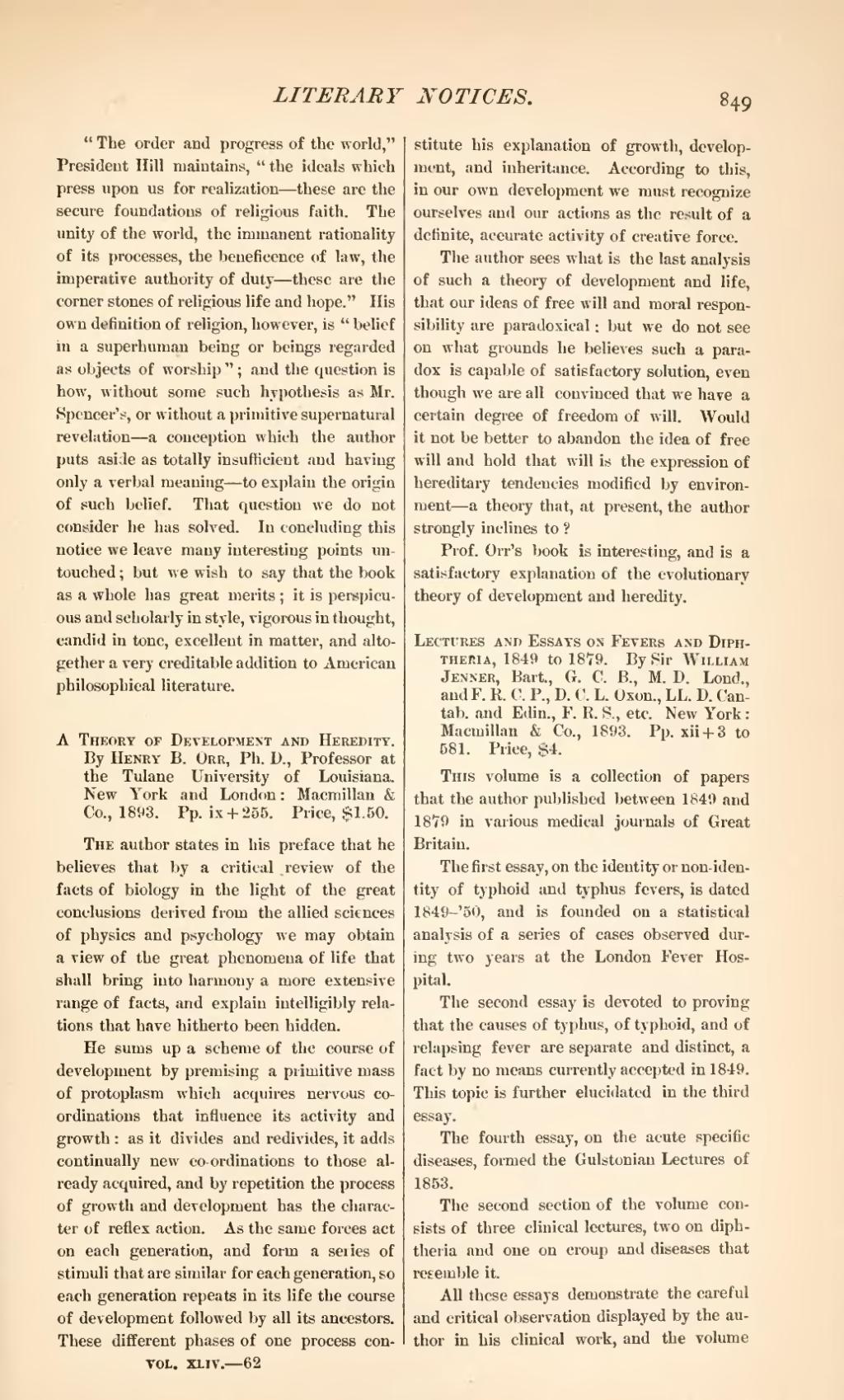"The order and progress of the world," President Hill maintains, "the ideals which press upon us for realization—these are the secure foundations of religious faith. The unity of the world, the immanent rationality of its processes, the beneficence of law, the imperative authority of duty—these are the corner stones of religious life and hope." His own definition of religion, however, is "belief in a superhuman being or beings regarded as objects of worship"; and the question is how, without some such hypothesis as Mr. Spencer's, or without a primitive supernatural revelation—a conception which the author puts aside as totally insufficient and having only a verbal meaning—to explain the origin of such belief. That question we do not consider he has solved. In concluding this notice we leave many interesting points untouched; but we wish to say that the book as a whole has great merits; it is perspicuous and scholarly in style, vigorous in thought, candid in tone, excellent in matter, and altogether a very creditable addition to American philosophical literature.
A Theory of Development and Heredity. By Henry B. Orr, Ph. D., Professor at the Tulane University of Louisiana. New York and London: Macmillan & Co., 1893. Pp. ix+255. Price, $1.50.
The author states in his preface that he believes that by a critical review of the facts of biology in the light of the great conclusions derived from the allied sciences of physics and psychology we may obtain a view of the great phenomena of life that shall bring into harmony a more extensive range of facts, and explain intelligibly relations that have hitherto been hidden.
He sums up a scheme of the course of development by premising a primitive mass of protoplasm which acquires nervous coordinations that influence its activity and growth: as it divides and redivides, it adds continually new co-ordinations to those already acquired, and by repetition the process of growth and development has the character of reflex action. As the same forces act on each generation, and form a series of stimuli that are similar for each generation, so each generation repeats in its life the course of development followed by all its ancestors. These different phases of one process constitute his explanation of growth, development, and inheritance. According to this, in our own development we must recognize ourselves and our actions as the result of a definite, accurate activity of creative force.
The author sees what is the last analysis of such a theory of development and life, that our ideas of free will and moral responsibility are paradoxical: but we do not see on what grounds he believes such a paradox is capable of satisfactory solution, even though we are all convinced that we have a certain degree of freedom of will. Would it not be better to abandon the idea of free will and hold that will is the expression of hereditary tendencies modified by environment—a theory that, at present, the author strongly inclines to?
Prof. Orr's book is interesting, and is a satisfactory explanation of the evolutionary theory of development and heredity.
Lectures and Essays on Fevers and Diphtheria, 1849 to 1879. By Sir William Jenner, Bart., G. C. B., M. D. Lond., and F. R. C. P., D. C. L. Oxon., LL. D. Cantab, and Edin., F. R. S., etc. New York: Macmillan & Co., 1893. Pp. xii-f 3 to 581. Price, $4.
This volume is a collection of papers that the author published between 1849 and 1879 in various medical journals of Great Britain.
The first essay, on the identity or non-identity of typhoid and typhus fevers, is dated 1849-'50, and is founded on a statistical analysis of a series of cases observed during two years at the London Fever Hospital.
The second essay is devoted to proving that the causes of typhus, of typhoid, and of relapsing fever are separate and distinct, a fact by no means currently accepted in 1849. This topic is further elucidated in the third essay.
The fourth essay, on the acute specific diseases, formed the Gulstonian Lectures of 1853.
The second section of the volume consists of three clinical lectures, two on diphtheria and one on croup and diseases that resemble it.
All these essays demonstrate the careful and critical observation displayed by the author in his clinical work, and the volume
